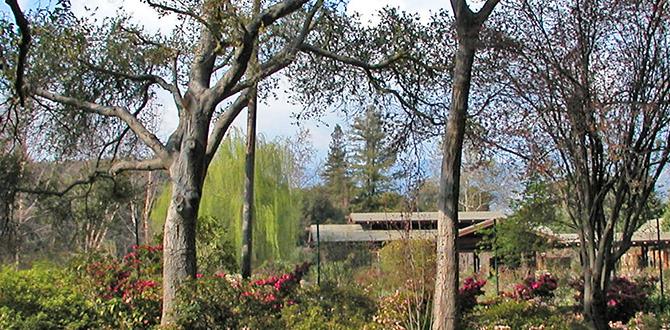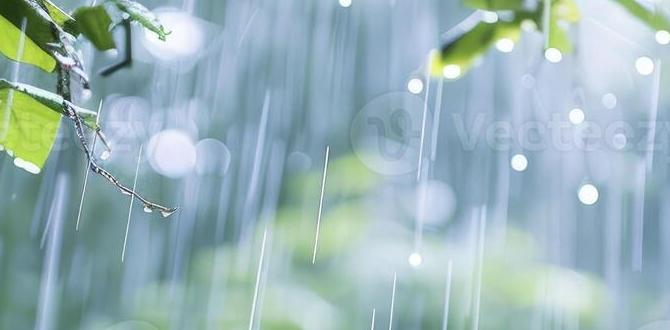Transform your living space and boost your well-being with an indoor water feature! This guide makes choosing, installing, and enjoying a serene water element easy and affordable for any home. Discover the tranquil beauty and calming sounds of water from the comfort of your living room.
Hello fellow green thumbs and home decorators! Pearl Roach here from EcoPatchy, and I’m so excited to talk about something that can truly bring a sense of calm and natural beauty into your home: an indoor water feature. Have you ever felt like your home was missing a little something special, a touch of nature that’s both visually appealing and soothing? Maybe you’ve seen beautiful fountains in magazines or found them in elegant shops and thought, “That’s lovely, but it’s probably too complicated and expensive for me.” Well, I’m here to tell you that creating your own tranquil water oasis indoors is more accessible than you might think! We’ll walk through everything you need to know, from picking the perfect piece to keeping it running smoothly, so you can enjoy the gentle sounds and sights of flowing water in your own sanctuary. Let’s dive in and discover how to bring this little slice of paradise home!
Why Consider an Indoor Water Feature for Your Home?
Adding an indoor water feature is more than just a decorative choice; it’s an investment in your home’s atmosphere and your personal well-being. The gentle trickling or flowing of water has a naturally calming effect, helping to reduce stress and promote relaxation. Think of it as a living piece of art that engages multiple senses. Besides the auditory pleasure, the mist from a water feature can increase humidity, which is fantastic for your skin, your houseplants, and can even help alleviate dry throat and sinus issues, especially during drier months. For those of us who love bringing elements of nature indoors, it’s a beautiful way to connect with the outdoors without leaving our cozy homes.
Beyond the sensory benefits, indoor water features can also act as natural air purifiers. As the water circulates, it can help trap dust particles and other airborne irritants, releasing cleaner, more humidified air back into your room. This is especially beneficial in urban environments or homes with central heating and air conditioning, which can often dry out the air.
A well-chosen water feature can also serve as a stunning focal point in any room. Whether you opt for a minimalist modern design, a rustic stone cascade, or a whimsical figurine, it adds a unique personality and aesthetic appeal to your decor. It’s a conversation starter and a way to express your personal style. Furthermore, the sound of water can mask distracting background noises, creating a more peaceful and focused environment, perfect for a home office or a quiet reading nook.
Exploring the Different Types of Indoor Water Features
The world of indoor water features is wonderfully diverse, offering options for every style, space, and budget. When you’re looking for that perfect addition to your home, consider these popular types:
Tabletop and Desk Fountains
These are the most common and beginner-friendly options. They are compact, portable, and require minimal setup. You can find them in a vast array of designs, from sleek modern metallic finishes to natural stone looks, often featuring small plants or decorative pebbles. They are perfect for adding a touch of tranquility to a desk, bookshelf, coffee table, or nightstand.
Wall-Mounted Water Features
For a more dramatic impact without taking up floor space, wall-mounted features are an excellent choice. They can range from simple panels with cascading water to elaborate designs with integrated lighting and natural elements. Installation might require a bit more effort, but the visual statement they make is significant.
Floor-Standing Fountains
These are larger and more substantial, designed to be a prominent decorative element in a room. They often mimic natural landscapes, with multiple tiers, rock formations, and sometimes even small ponds or planter areas. They require more space but can completely transform the ambiance of a living room, foyer, or sunroom.
Buddha and Zen Gardens
Emphasizing tranquility and mindfulness, these features often incorporate elements like Buddha statues, bamboo, raked sand, or minimalist rock arrangements. They are designed to create a serene and meditative atmosphere, making them popular for meditation corners or relaxation spaces.
Animal and Figure Fountains
If you have a love for a particular animal or a whimsical theme, these fountains feature cute animal figurines, cherubs, or other decorative figures from which water flows. They can add a charming and playful touch to a home, often popular in family rooms or children’s spaces.
Modern and Minimalist Designs
Characterized by clean lines, geometric shapes, and often using materials like metal, glass, or polished stone, these features complement contemporary interior design. They focus on sleek aesthetics and subtle water movement, creating a sophisticated and tranquil feel.
Choosing the Right Indoor Water Feature for Your Home
Selecting the perfect indoor water feature involves a few considerations to ensure it’s a great fit for your space and lifestyle. Let’s break down what to think about:
1. Space and Size
Measure the area where you plan to place your water feature. Is it a small corner on a side table, a large empty floor space, or a wall that needs a statement piece? Ensure the dimensions of the feature fit comfortably without making the room feel cluttered. A tiny feature in a vast room might get lost, while an oversized one in a small apartment can feel intrusive.
2. Aesthetics and Style
This is where you get to have fun! Consider your existing decor. Do you have a modern, minimalist home, or a more rustic, traditional style? Choose a water feature that complements or enhances your current interior design. Materials like natural stone, ceramic, metal, or resin all offer different looks and feels.
3. Noise Level
The sound of water is usually a major draw, but the intensity of that sound can vary greatly. Some features offer a gentle, barely-there trickle, while others provide a more robust, spa-like sound. Think about where the feature will be. If it’s in a bedroom, a quiet trickle might be best for sleep. In a living area, a more noticeable sound might be more engaging. Check product descriptions for noise level descriptions or look for videos that showcase the sound.
4. Maintenance Requirements
Be realistic about how much time you’re willing to dedicate to maintenance. Some features are virtually maintenance-free, while others require regular cleaning, water top-ups, and possibly pump checks. Factors like the pump’s power, the presence of plants, and the complexity of the design can affect how much upkeep is needed.
5. Budget
Indoor water features can range from under $50 for a small tabletop fountain to several hundred dollars or more for elaborate floor-standing or wall-mounted units. Set a budget beforehand. Remember to also factor in potential costs for cleaning supplies, replacement bulbs for lighting, or even a small rug if you’re concerned about water splashes.
6. Features and Add-ons
Some water features come with built-in LED lights to enhance their visual appeal, especially in the evening. Others might have integrated planters for small indoor plants, adding a biophilic touch. Decide if these extra features are important to you.
Essential Components of an Indoor Water Feature
No matter the size or style of your indoor water feature, there are a few key components that work together to bring it to life:
1. Reservoir or Basin
This is the base of your water feature, holding all the water. It needs to be watertight and large enough to submerge the pump fully and prevent water from splashing out too easily. Most commercially made features have integrated basins.
2. Pump
The heart of your water feature! A small submersible pump circulates the water from the reservoir up through the tubing to create the flow and sound. Pumps vary in power, which affects the water flow rate and height it can push the water. Look for an adjustable flow rate if you want to fine-tune the sound.
3. Tubing
This flexible tubing connects the pump to the point where the water emerges, guiding the water’s path. The size of the tubing will depend on the pump’s outlet and the design of the feature.
4. Water Spout or Spitter
This is the part from which the water gracefully exits. It could be a simple spout, a series of cascades over rocks, or a decorative figure with a hole for water to flow through.
5. Decorative Elements
These are the aesthetic additions that give your water feature its unique character. They can include pebbles, rocks, artificial or real plants, figurines, LED lights, and more. These not only enhance the visual appeal but can also help soften the sound of the falling water.
6. Power Source
Virtually all indoor water feature pumps require electricity to run. They usually come with a power cord that needs to be plugged into a standard electrical outlet. It’s wise to have an outlet nearby or use a suitable extension cord, ensuring it’s routed safely away from any potential water exposure.
How to Set Up Your Indoor Water Feature: A Step-by-Step Guide
Setting up your new indoor water feature is usually straightforward. Here’s a general guide to get you started. Always refer to the manufacturer’s instructions for your specific model, as steps can vary slightly.
Step 1: Unpack and Inspect
Carefully unpack all the components. Lay them out and check for any damage that might have occurred during shipping. Ensure you have all the parts listed in the manual.
Step 2: Choose Your Location
Select a stable, level surface for your water feature. Consider proximity to an electrical outlet. It’s also a good idea to place it on a surface that can tolerate a little moisture or protect it with a waterproof mat, especially if it’s on a wooden table or floor. Avoid placing it directly in sunlight, as this can encourage algae growth.
Step 3: Assemble the Base and Pump
Place the basin or reservoir in its chosen spot. Position the pump inside the basin, usually at the bottom. If the pump has suction cups, press them firmly onto the surface to secure it.
Step 4: Connect the Tubing
Attach one end of the flexible tubing to the pump’s outlet. If there are multiple tubing options or attachments, ensure you use the one specified for your feature’s water flow design. Run the other end of the tubing to where you want the water to emerge (e.g., through a decorative spout, over rocks).
Step 5: Add Decorative Elements
Arrange any decorative rocks, pebbles, plants, or figurines around the pump and tubing. Ensure they don’t block the water flow or the pump’s intake. This is also where you can hide the pump and tubing for a more natural look.
Step 6: Fill with Water
Using distilled water is often recommended to minimize mineral buildup and algae. Fill the reservoir until the pump is fully submerged, following the manufacturer’s minimum and maximum water level guidelines. Do NOT turn on the pump until it is fully submerged, as this can damage it.
Step 7: Plug In and Adjust
Ensure your hands are dry, plug the pump into the electrical outlet. The water should start flowing. You may need to adjust the pump’s flow setting (if applicable) to achieve your desired sound and water effect. You might also need to reposition decorative elements to get the perfect cascade.
Step 8: Check for Splashing
Observe the water flow for a few minutes to ensure there isn’t excessive splashing outside the basin. If there is, you may need to adjust the water flow rate or reposition the decorative elements to redirect the water back into the basin.
Maintaining Your Indoor Water Feature for Smooth Operation
To keep your indoor water feature looking and sounding its best, a little regular maintenance goes a long way. It prevents issues like pump failure, algae buildup, and keeps the water looking clear and inviting.
Daily Checks
Water Level: Check the water level daily, especially in warmer climates or if you have a fan nearby, as water can evaporate. Top up with distilled water as needed to keep the pump submerged. This is the most crucial step to prevent pump damage.
Weekly Maintenance
Water Clarity: If the water is starting to look cloudy or if you see any signs of algae, it’s time for a clean. You can use a small net or brush to remove any debris.
Top up Water: Top up the reservoir with distilled water. If you notice mineral deposits forming on the feature, consider using distilled water exclusively. For further clarity and to prevent algae, consider a water clarifier additive, but always choose products safe for indoor water features.
Monthly Cleaning
Deep Clean: Once a month, it’s a good idea to perform a more thorough cleaning. Unplug the pump. Carefully dismantle any removable parts. Empty and rinse the basin. Clean the pump housing and intake to remove any sediment or debris. A soft brush or cloth can be helpful. You can clean the decorative elements separately. For stubborn algae, a dilute solution of white vinegar and water can be effective, but rinse thoroughly afterward. Reassemble, refill with distilled water, and restart the pump.
Pump Maintenance: Check the pump’s intake screen for clogs. Most pumps have a cover that can be removed to access and clean the impeller and intake area. This ensures optimal water flow and pump longevity. You can find helpful resources on pump care from manufacturers like[^1^] Little Giant, a reputable pump supplier.
Seasonal Considerations
Algae Control: In summer, algae growth can be more aggressive. Regularly cleaning and maintaining the water level is key. Some people resort to a small amount of hydrogen peroxide (food-grade is best, but check safety for your specific feature) to combat algae, but always research the recommended dosage and safety precautions for your unit.
Winterizing (if applicable): If you live in a cold climate and plan to store the water feature for an extended period (e.g., during a long vacation in winter), it’s best to drain it completely, clean it, and store it in a protected area. This prevents any potential damage from freezing temperatures.
The Array of Benefits an Indoor Water Feature Brings
Integrating an indoor water feature into your home offers a delightful blend of aesthetic enhancement and well-being benefits:
Stress Reduction and Relaxation
The consistent, gentle sound of flowing water is incredibly soothing. It can help lower stress levels, reduce anxiety, and promote a sense of calm and tranquility throughout your living space. It transforms a room into a personal sanctuary, perfect for unwinding after a long day.
Improved Air Quality and Humidity
As water evaporates from the feature, it naturally increases the humidity in the air. This can be particularly beneficial in dry climates or during winter months when heating systems tend to deplete indoor humidity. Increased humidity can alleviate dry skin, irritated sinuses, and even help keep your houseplants thriving. The moving water also helps to filter out dust and airborne particles, contributing to cleaner air.
Natural Sound Machine
The ambient sound of water can effectively mask disruptive noises from outside traffic, neighbors, or household appliances. This creates a more peaceful environment, conducive to concentration, relaxation, and better sleep. It’s a beautiful alternative to artificial white noise machines.
Aesthetic Appeal and Focal Point
A well-chosen water feature can be a stunning piece of living art. It adds visual interest, texture, and movement to your decor, becoming an instant




